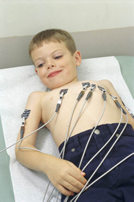| Drug & Brand Names |
Drug Class (Clinical Use) |
| Arsenic trioxide (Trisenox�) |
Anti-cancer/Leukemia |
| Bepridil (Vascor�) |
Anti-anginal/heart pain |
| Chlorpromazine (Thorazine�) |
Anti-psychotic/Anti-emetic/schizophrenia/nausea |
| Cisapride (Propulsid�) |
GI stimulant/heartburn |
| Clarithromycin (Biaxin�) |
Antibiotic/bacterial infection |
| Disopyramide (Norpace�) |
Anti-arrhythmic/abnormal heart rhythm |
| Dofetilide (Tikosyn�) |
Anti-arrhythmic/abnormal heart rhythm |
| Dolasetron (Anzemet�) |
Anti-nausea/nausea, vomiting |
| Droperidol (Inapsine�) |
Sedative;Anti-nausea/anesthesia adjunct, nausea |
| Erythromycin (E.E.S.� ,Erythrocin�) |
Antibiotic;GI stimulant/bacterial infection; increase GI motility |
| Felbamate (Felbatrol�) |
Anti-convulsant/seizure |
| Fluoxetine (Prozac�,Sarafem�) |
Anti-depressant/depression |
| Foscarnet (Foscavir�) |
Anti-viral/HIV infection |
| Fosphenytoin (Cerebyx�) |
Anti-convulsant/seizure |
| Gatifloxacin (Tequin�) |
Antibiotic/bacterial infection |
| Halofantrine (Halfan�) |
Anti-malarial/malaria infection |
| Haloperidol (Haldol�) |
Anti-psychotic/schizophrenia, agitation |
| Ibutilide (Corvert�) |
Anti-arrhythmic/abnormal heart rhythm |
| Indapamide (Lozol�) |
Diuretic/stimulate urine & salt loss |
| Isradipine (Dynacirc�) |
Anti-hypertensive/high blood pressure |
| Levofloxacin (Levaquin�) |
Antibiotic/bacterial infection |
| Levomethadyl (Orlaam�) |
Opiate agonist/pain control, narcotic dependence |
| Mesoridazine (Serentil�) |
Anti-psychotic/schizophrenia |
| Moexipril/HCTZ (Uniretic�) |
Anti-hypertensive/high blood pressure |
| Moxifloxacin (Avelox�) |
Antibiotic/bacterial infection |
| Naratriptan (Amerge�) |
Serotonin receptor agonist/Migraine treatment |
| Nicardipine (Cardene�) |
Anti-hypertensive/high blood pressure |
| Octreotide (Sandostatin�) |
Endocrine/acromegaly, carcinoid diarrhea |
| Paroxetine (Paxil�) |
Anti-depressant/depression |
| Pentamidine (NebuPent�,Pentam�) |
Anti-infective/pneumocystis pneumonia |
| Pimozide (Orap�) |
Anti-psychotic/Tourette's tics |
| Procainamide (Procan� ,Pronestyl�) |
Anti-arrhythmic/abnormal heart rhythm |
| Quetiapine (Seroquel�) |
Anti-psychotic/schizophrenia |
| Quinidine (Cardioquin�, Quiniglute�) |
Anti-arrhythmic/abnormal heart rhythm |
| Risperidone (Risperdal�) |
Anti-psychotic/schizophrenia |
| Salmeterol (Serevent�) |
Sympathomimetic/asthma, COPD |
| Sertraline (Zoloft�) |
Anti-depressant/depression |
| Sotalol (Betapace�) |
Anti-arrhythmic/abnormal heart rhythm |
| Sparfloxacin (Zagam�) |
Antibiotic/bacterial infection |
| Sumatriptan (Imitrex�) |
Serotonin receptor agonist/Migraine treatment |
| Tacrolimus (Prograf�) |
Immunosuppressant/Immune suppression |
| Tamoxifen (Nolvadex�) |
Anti-cancer/breast cancer |
| Thioridazine(Mellaril�) |
Anti-psychotic/schizophrenia |
| Tizanidine (Zanaflex�) |
Muscle relaxant |
| Venlafaxine (Effexor�) |
Anti-depressant/depression |
| Ziprasidone(Geodon�) |
Anti-psychotic/schizophrenia |
| Zolmitriptan (Zomig�) |
Migraine treatment |


 Long QT Syndrome (LQTS) is a disorder of the electrical system that triggers the heartbeat, and regulates the muscle contractions that pump the body's blood supply. There are two types of LQTS:
Long QT Syndrome (LQTS) is a disorder of the electrical system that triggers the heartbeat, and regulates the muscle contractions that pump the body's blood supply. There are two types of LQTS: Most people are familiar with electrocardiography (ECG or EKG), a test in which electrodes are temporarily attached onto the chest, arms and legs to record the heart's electrical activity. The electrodes send information to a machine that records and prints a "picture" (an electrocardiogram) of the pattern, or rhythm, of the electrical impulses that pace the heart beat. Each impulse generates a heart beat. The line created for each beat on the ECG is called a "waveform."
Most people are familiar with electrocardiography (ECG or EKG), a test in which electrodes are temporarily attached onto the chest, arms and legs to record the heart's electrical activity. The electrodes send information to a machine that records and prints a "picture" (an electrocardiogram) of the pattern, or rhythm, of the electrical impulses that pace the heart beat. Each impulse generates a heart beat. The line created for each beat on the ECG is called a "waveform."
